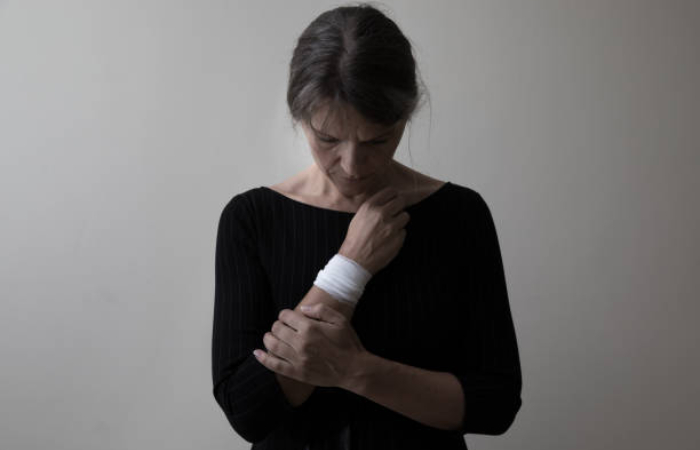988 Lifeline is a nationwide network of local crisis centres that provide free self-harm scars, confidential emotional support to people feeling suicidal crisis or emotional distress 24 hours a day, 7 days a week, in the United States. If there is immediate danger of harm, you can also call 911 for emergency mental health crisis support.
Self-harm scars are not uncommon in the United States. It is the act of repeated self-harm of the body by cutting, burning or picking as a means of coping with emotional pain, according to the Eisenberg Center for Family Depression at the University of Michigan.
This behaviour is common among teenagers and young adults. Each person’s experience is unique. Some people have one episode of self-harm, while others have several. There are evidence-based mental health treatments to help manage self-harm and mental health issues that may be fueling the behaviour. Many can develop better-coping mechanisms and leave self-harm behind. However, scars from past episodes can cause shame, unpleasant memories of suffering, and judgment from others.
Suppose you are seeking treatment for self-harm scars. In that case, it is recommended that you undergo a thorough examination by a board-certified plastic surgeon who is an ASPS member to determine the best treatment. If applicable, a direct referral from your primary care physician, mental health counsellor, psychologist, or psychiatrist can also help improve your treatment.
Understanding self-harm scars
Self-harm scars are rarely acknowledged by family and friends, often leading to further feelings of physical and emotional isolation. Feelings of guilt, regret, and fear of social embarrassment can also discourage people from seeking medical help. Treatment for self-harm scars begins with a thorough medical examination to assess your emotional and physical well-being to enable scar correction.
There can be many different types of self-harm scars on the face and body, making it challenging to choose treatment options for the problem. Most doctors start by assessing the characteristics of the wound or scar to determine whether a particular scar requires emergency care or long-term care. Open wounds often require immediate treatment, while older scars may require multiple treatment sessions spaced out over time to improve the appearance of the scar.
Are you Emotionally Ready for Treatment?

Your emotional state can also influence your doctor’s decision to start treatment. Patients often experience strong emotional reactions when talking about their self-harm scars, so it’s essential to have a strong support system to accompany you on your healing journey. ASPS advocates for complementary treatment approaches related to plastic surgery to improve the overall quality of life for those seeking treatment.
Telephone, online chat and direct patient-clinician resources are available to help you cope with the emotional and psychological challenges of dealing with self-harm scars and mental health support. Many of these services provide expertise aimed at teens and adults facing emotional and mental health issues.
Medical treatment for self-harm scars has many benefits beyond improving the appearance of the wounds.
“Treating scars from self-harm can help those who have overcome this behaviour,” said Gregory Sayer, MD, DFAACAP, a board-certified psychiatrist specializing in child, adolescent, and adult psychiatry.
Newly formed scars from self-harm
Time is of the essence if the scar is actively bleeding, infected, or requires emergency treatment. This can help reduce scarring in the long run. Call 911, your local emergency department, or crisis centres immediately for suicide and self-harm support. 988 Suicide & Crisis Lifeline experts are available 24 hours a day, 7 days a week.
In an emergency or urgent care setting, your doctor may recommend local wound support, emergency suturing, or laceration/burn care to help reduce the complexity of your injury. These decisions can only be made after a thorough examination and should be based on direct medical care provided by a qualified physician.
An urgent care or emergency physician may seek help from a wound care specialist or a plastic surgeon if the wounds are complex or extensive. Proper wound care can minimize future scarring by reducing complications associated with poor wound healing. By speeding up the wound healing process, you can reduce the need for more complex scar revisions in the future.
Treating Mature Self-Harm Scars

Seeking treatment for self-harm scars begins with studying the characteristics of the scar. This includes texture, colour, scar configuration, contour, level of inflammation, and microtopography. These scars may be raised and thickened, while others may be sunken and atrophied.
A board-certified flexible surgeon who is an ASPS member can help you evaluate your scar to determine the best treatment option, whether scar correction surgery, drug therapy, non-surgical treatment, or combination therapy.
Scar correction surgery for self-harm scars
There is no typical self-harm scar. Clinicians may see patterned linear incision lines or heterogeneous lesions without uniformity. Depending on your scar type, your surgeon may suggest scar revision surgery to help improve your scar. Patients need to understand the risks and have reasonable expectations regarding scar correction. Scar treatment does not produce scar-free skin but enhances the appearance of an existing scar.
There are many surgical options for scar correction. Scar excision removes thinner scars in favour of a thinner scar. However, there are limitations to this procedure that can affect the amount of improvement you see in the appearance of your scar. A thorough medical examination and health evaluation determine the most appropriate scar correction method.
Red, inflamed scars
Newly formed scars may appear pink or red as they heal. Redness is usually caused by decreasing inflammation and the development of microscopic blood vessels under the skin. Redness and residual inflammation may respond well to laser therapy or phototherapy. The two most common treatments for superficial redness include pulsed dye laser (PDL) or intense pulsed light (IPL) treatments, which target the scar colour.
Both PDL and IPL treatments have limited recovery time and temporary redness that lasts several hours. In most cases, multiple procedures are required, which can be combined with other approaches for scar correction. The number of sessions required usually depends on the severity of the inflammation and redness of the scar, as well as your skin tone.
Scar Discolouration Treatment

Scar discolouration is caused by abnormal deposits of melanin or hemosiderin pigmentation in the skin. Hyperpigmentation can be exacerbated by prolonged wound healing, chronic inflammation, sun exposure and wound infection.
Another problem with hyperpigmentation is the development of pigment rims, a process in which the central scar is not pigmented and a rim of discolouration forms on the outer edge of the scar. Hyperpigmented discolouration can be treated in various ways, including arbutin-based skin-lightening medications or ointments, tyrosinase inhibitors, rapid exfoliation, and retinoids. Clinical treatments include laser therapy, phototherapy, rapid exfoliation protocols, and glowing peels.
There may also be hypopigmentation. Poorly closed wounds from self-harm can lose their colour. These scars are challenging to treat as there is little opportunity for scar re-pigmentation. Options include plasma pixilation, a process designed to redirect pigmentation in hypopigmented scars using fractionated plasma therapy.
Colour differences in self-harm scars may also respond well to treatment with medical pigment tattoos. There are risks when treating tattoo scars, including future changes in tattoo colour, tattoo ink bleeding within the scar, and
oxidation of tattoo pigments, which causes discolouration within the scar tissue.
Textured scars
Scar texture is significant in repairing self-harm scars. It may have a surface texture different from the surrounding normal skin. This can affect the appearance of the scar under different lighting conditions.
In most cases, these texture differences are permanent but can be improved with lasers that add depth and
volume to the scar surface. Many of the changes after laser are minor but can slightly improve the appearance of your skin.
Self-harm scar treatment with plastic surgery
Self-harm scars can be improved by using a specific approach to assessing, diagnosing, and treating scars. The review should be a team effort that includes optimizing your mental health, support system, family and friends,
plastic surgeon and primary care physician when appropriate.
Your emotional preparation for surgical or non-surgical scar revision should be tempered by realistic expectations and an understanding that multiple procedures may be required and improvements may be gradual. As with any
procedure, correctly understanding informed consent is important in assessing your readiness for treatment and the risks of each procedure.


